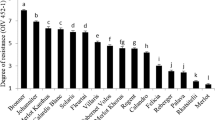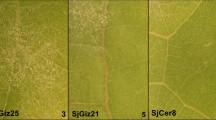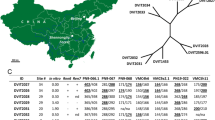Abstract
Downy mildew resistance is a quantitative trait in grapevines of the genus Vitis. The grapevine ‘Bianca’ has retained resistance, originally present in its North American ancestors, through several cycles of backcrossing with susceptible cultivars of Vitis vinifera followed by phenotypic selection. The genetic control of the trait was studied using 116 full-siblings from the cross ‘Chardonnay’ × ‘Bianca’ and parental genetic maps consisting of 298 and 312 markers, respectively. Ratings of resistance and histological identification of the stage of interaction, when pathogen development is impaired in resistant individuals, were performed using leaf disc inoculation assays with two isolates of Plasmopara viticola collected in Italian and French vineyards. ‘Bianca’ and 59% of its offspring were heterozygous for a dominant gene, located in a 2.9 cM interval at the Rpv3 locus on chromosome 18, responsible for the onset of a hypersensitive response (HR) at the infection sites within 2 days post inoculation (dpi). Localised necrosis was the earliest phenotypic difference compared to susceptible individuals, it did not halt pathogen growth, but it was associated with a significant reduction of pathogen performance and disease symptoms from 3 to 6 dpi. QTL peaks for quantitative ratings revealed the strongest effects being caused by the Rpv3 locus: extent of mesophyll colonisation (LOD 3.1, percentage of explained phenotypic variance 16.2%), sporulation density (29.7, 74.3%), and symptom severity expressed by the OIV452 descriptor recommended by the Office International de la Vigne et du Vin (28.3, 74.6%). Strong correlation was observed between the ability of a seedling to mount an HR under controlled experimental conditions and quantitative resistance of the adult plant exposed to natural infections in the field, which was expressed by the number of leaves with fungal sporulation, in two consecutive years of observations.



Similar content being viewed by others
References
Anonymous (1983) Descriptor list for grapevine varieties and Vitis species. Office International de la Vigne et du Vin (OIV), Paris
Barker CL, Donald T, Pauquet J, Ratnaparkhe A, Bouquet A, Adam-Blondon A-F, Thomas MR, Dry I (2005) Genetic and physical mapping of the grapevine powdery mildew resistance gene, Run1, using a bacterial artificial chromosome library. Theor Appl Genet 111:370–377
Boubals D (1959) Amélioration de la résistance de la vigne au mildiou (Plasmopara viticola (Berk et Curt.) Berlese et de Toni). Recherche de géniteurs de résistance. Annales de l’Amélioration des Plantes 6:481–525
Brown MV, Moore JN, Fenn P, McNew RW (1999) Comparison of leaf disk, greenhouse and field screening procedures for evaluation of grape seedlings for downy mildew resistance. Hortscience 34:331–333
Cadle-Davidson L (2008) Variation within and between Vitis spp. for foliar resistance to the downy mildew pathogen Plasmopara viticola. Plant Dis 92:1577–1584
Cipriani G, Di Gaspero G, Canaguier A, Jusseaumes J, Tassin J, Lemainque A, Roux C, Adam-Blondon A-F, Testolin R (2009) Molecular linkage maps: strategies, resources and achievements. In: Zapater MM, Adam-Blondon AF (eds) Grapes. In: Chittaranjan Kole (Series ed) Series on “Genomics of fruit and vegetables crops”. Sciences Publishers, Enfield NH, USA
Csizmazia J, Bereznai L (1968) A szõlõ Plasmopara viticola és a Viteus vitifolii elleni rezisztencia nemesités eredményei. Orsz Szõl Bor Kut Int Évkönyve, Budapest:191–200
Dai GH, Andary C, Mondolot-Cosson L, Boubals D (1995) Histochemical studies on the interaction between three species of grapevine, Vitis vinifera, V. rupestris and V. rotundifolia and the downy mildew fungus, Plasmopara viticola. Physiol Mol Plant Pathol 46:177–188
Di Gaspero G, Cipriani G (2002) Resistance gene analogs are candidate markers for disease-resistance genes in grape (Vitis spp.). Theor Appl Genet 106:163–172
Di Gaspero G, Cipriani G, Adam-Blondon A-F, Testolin R (2007) Linkage maps of grapevine displaying the chromosomal locations of 420 microsatellite markers and 82 markers for R-gene candidates. Theor Appl Genet 114:1249–1263
Díez-Navajas AM, Greif C, Poutaraud A, Merdinoglu D (2007) Two simplified fluorescent staining techniques to observe infection structures of the oomycete Plasmopara viticola in grapevine leaf tissues. Micron 38:680–683
Díez-Navajas AM, Wiedemann-Merdinoglu S, Greif C, Merdinoglu D (2008) Nonhost versus host resistance to the grapevine downy mildew, Plasmopara viticola, studied at the tissue level. Phytopathology 98:776–780
Doligez A, Adam-Blondon AF, Cipriani G, Di Gaspero G, Laucou V, Merdinoglu D, Meredith CP, Riaz S, Roux C, This P (2006) An integrated SSR map of grapevine based on five mapping populations. Theor Appl Genet 113:369–382
Eibach R, Töpfer R (2003) Success in resistance breeding: ‘Regent’ and its steps into the market. Acta Hort 687–691
Fischer BM, Salakhutdinov I, Akkurt M, Eibach R, Edwards KJ, Töpfer R, Zyprian EM (2004) Quantitative trait locus analysis of fungal disease resistance factors on a molecular map of grapevine. Theor Appl Genet 108:501–515
Gindro K, Pezet R, Viret O (2003) Histological study of the responses of two Vitis vinifera cultivars (resistant and susceptible) to Plasmopara viticola infections. Plant Physiol Biochem 41:846–853
Gobbin D, Jermini M, Loskill B, Pertot I, Raynal M, Gessler C (2005) Importance of secondary inoculum of Plasmopara viticola to epidemics of grapevine downy mildew. Plant Pathol 54:522–534
Iwanov J, Waltschev W (1973) The inheritance of features of cold hardiness and Plasmopara resistance by interspecific hybridization of vines. International Symposium of vine breeding. Geilweilerhof, Siebeldingen, Germany, 25–29 September 1973
Jaillon O, Aury J-M, Noel B, Policriti A, Clepet C et al (2007) The grapevine genome sequence suggests ancestral hexaploidization in major angiosperm phyla. Nature 449:463–468
Jürges G, Kassemeyer H-H, Dürrenberger M, Düggelin M, Nick P (2009) The mode of interaction between Vitis and Plasmopara viticola Berk. & Curt. Ex de Bary depends on the host species. Plant Biol. doi:10.1111/j.1438-8677.2008.00182.x
Kast WK, Stark-Urnau M, Seidel M, Gemmrich AR (2001) Inter-isolate variation of virulence of Plasmopara viticola on resistant vine varieties. Bull OILB/SROP 24:45–49
Kennelly MM, Eugster C, Gadoury DM, Smart CD, Seem RC, Gobbin D, Gessler C (2005a) Contributions of oospore inoculum to epidemics of grapevine downy mildew (Plasmopara viticola). Phytopathology 94:S50
Kennelly MM, Gadoury DM, Wilcox WF, Magarey PA, Seem RC (2005b) Seasonal development of ontogenic resistance to downy mildew in grape berries and rachises. Phytopathology 95:1445–1452
Kortekamp A, Zyprian E (2003) Characterization of Plasmopara-resistance in grapevine using in vitro plants. J Plant Physiol 160:1393–1400
Marguerit E, Boury C, Manicki A, Donnart M, Butterlin G, Némorin A, Wiedemann-Merdinoglu S, Merdinoglu D, Ollat N, Decroocq S (2009) Genetic dissection of sex determinism, inflorescence morphology and downy mildew resistance in grapevine. Theor Appl Genet 118:1261–1278
Merdinoglu D, Wiedemann-Merdinoglu S, Coste P, Dumas V, Haetty A, Butterlin G, Greif C (2003) Genetic analysis of downy mildew resistance derived from Muscadinia rotundifolia. Acta Hort 603:451–456
Moroldo M, Paillard S, Marconi R, Fabrice L, Canaguier A, Cruaud C, De Berardinis V, Guichard C, Brunaud V, Le Clainche I, Scalabrin S, Testolin R, Di Gaspero G, Morgante M, Adam-Blondon AF (2008) A physical map of the heterozygous grapevine ‘Cabernet Sauvignon’ allows mapping candidate genes for disease resistance. BMC Plant Biol 8:66
Staudt G, Kassemeyer HH (1995) Evaluation of downy mildew resistance in various accessions of wild Vitis species. Vitis 34:225–228
Unger S, Büche C, Boso S, Kassemeyer HH (2007) The course of colonization of two different Vitis genotypes by Plasmopara viticola indicates compatible and incompatible host-pathogen interaction. Phytopathology 97:780–786
Van Ooijen JW (2004) MapQTL 5, Software for the mapping of quantitative trait loci in experimental populations. Kyazma B.V., Netherlands
Welter LJ, Göktürk-Baydar N, Akkurt M, Maul E, Eibach R, Töpfer R, Zyprian EM (2007) Genetic mapping and localization of quantitative trait loci affecting fungal disease resistance and leaf morphology in grapevine (Vitis vinifera L). Mol Breed 20:359–374
Zyprian E, Akkurt M, Fischer B, Salakhutdinov, Welter L, Kortekamp A, Eibach R, Töpfer R (2005) Fundamental research meets practical breeding: genetics of disease resistance in grapevine. In: W Qiu and LG Kovacs (eds) Proceedings of the International Grape Genomics Symposium, July 12–14, 2005. St. Louis, Missouri, pp 163–168
Acknowledgments
This research was supported by funds from the Italian Ministry of Agriculture, VIGNA project; from the Italian Ministry of Education and Research PRIN2006 no. 2006073137; from the Regional Government of Friuli Venezia Giulia, Grape Breeding Project; from INRA and the ANR GrapeSeq project. We thank P. Coste, G. Comuzzo, and R. Frezza for technical assistance in plant and inoculum maintenance, D. Copetti for help in field scorings, and C. Coleman for proofreading the manuscript.
Author information
Authors and Affiliations
Corresponding author
Additional information
Communicated by M. Xu.
Electronic supplementary material
Below is the link to the electronic supplementary material.
Supplementary Material S1
– Overview of the experimental design and description of the parameters evaluated in the segregating progeny for describing different components of the resistance trait.(PDF 418 kb)
Supplementary Material S2
– Rainfall (red line expressed in mm), air temperature (minimum, mean, and maximum temperatures, black lines expressed in °C), and relative humidity (green line expressed in %) recorded at the site of field evaluation, during the period of the primary infection when downy mildew symptoms in the ‘Chardonnay’ × ‘Bianca’ progeny under natural conditions were observed. Arrows indicate the date when the number of sporulating leaves was recorded for each individual and used for QTL analysis of disease resistance/susceptibility. (JPG 1475 kb)
Supplementary Material S3
– Consensus genetic map obtained from 116 offspring of the cross ‘Chardonnay’ ×’Bianca’. Distances are given in Kosambi cM. Multi-locus markers are identified by the marker name, suffixed by the code of the parent (–CH for ‘Chardonnay’, and –BI for ‘Bianca’), and when necessary, by a letter (–A, and –B) standing for each non-allelic peak (band) segregating from a given parent. (JPG 1606 kb)
Supplementary Material S4
– Details of parental maps used for mapping. (PDF 10 kb)
Rights and permissions
About this article
Cite this article
Bellin, D., Peressotti, E., Merdinoglu, D. et al. Resistance to Plasmopara viticola in grapevine ‘Bianca’ is controlled by a major dominant gene causing localised necrosis at the infection site. Theor Appl Genet 120, 163–176 (2009). https://doi.org/10.1007/s00122-009-1167-2
Received:
Accepted:
Published:
Issue Date:
DOI: https://doi.org/10.1007/s00122-009-1167-2




